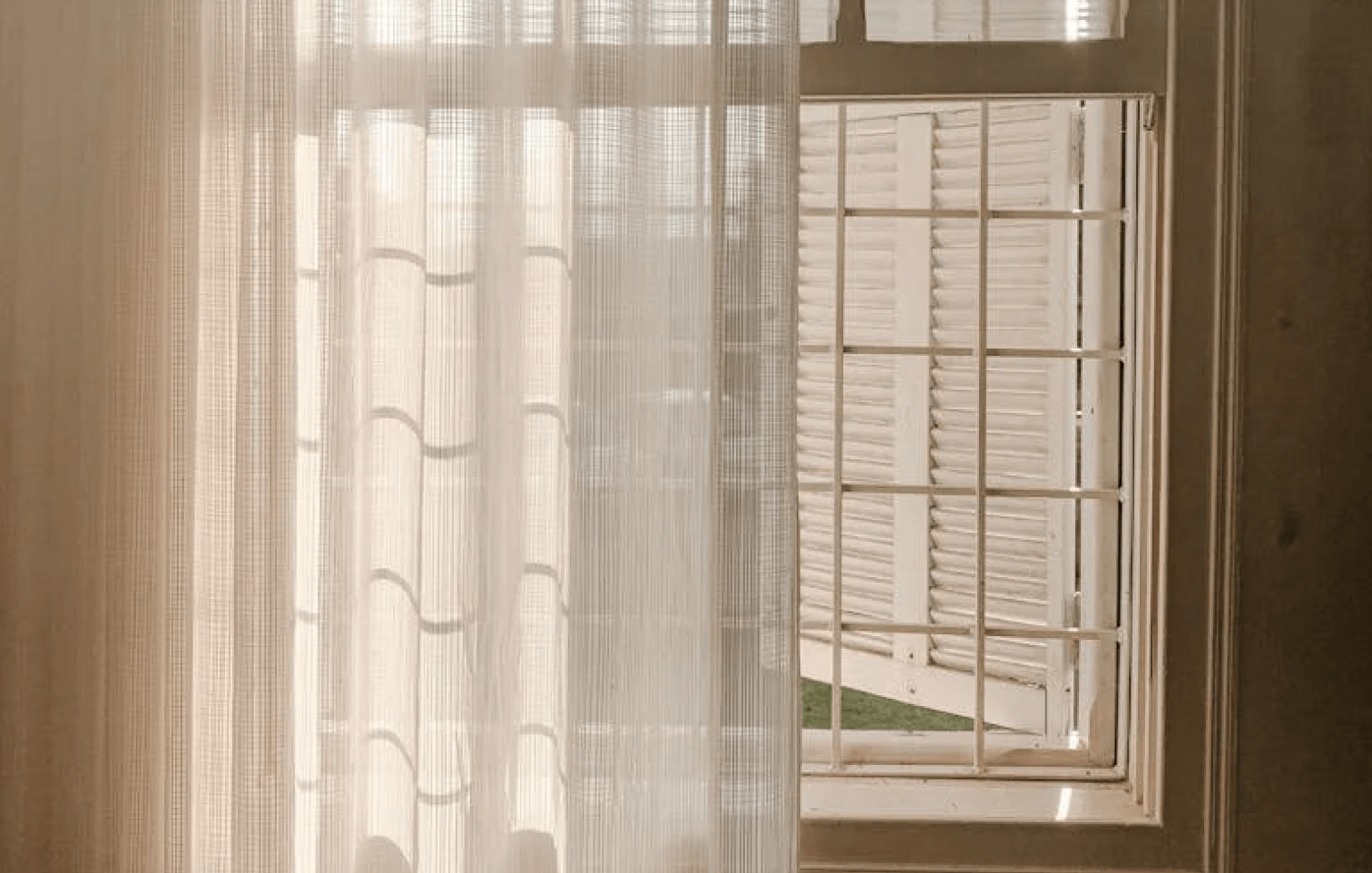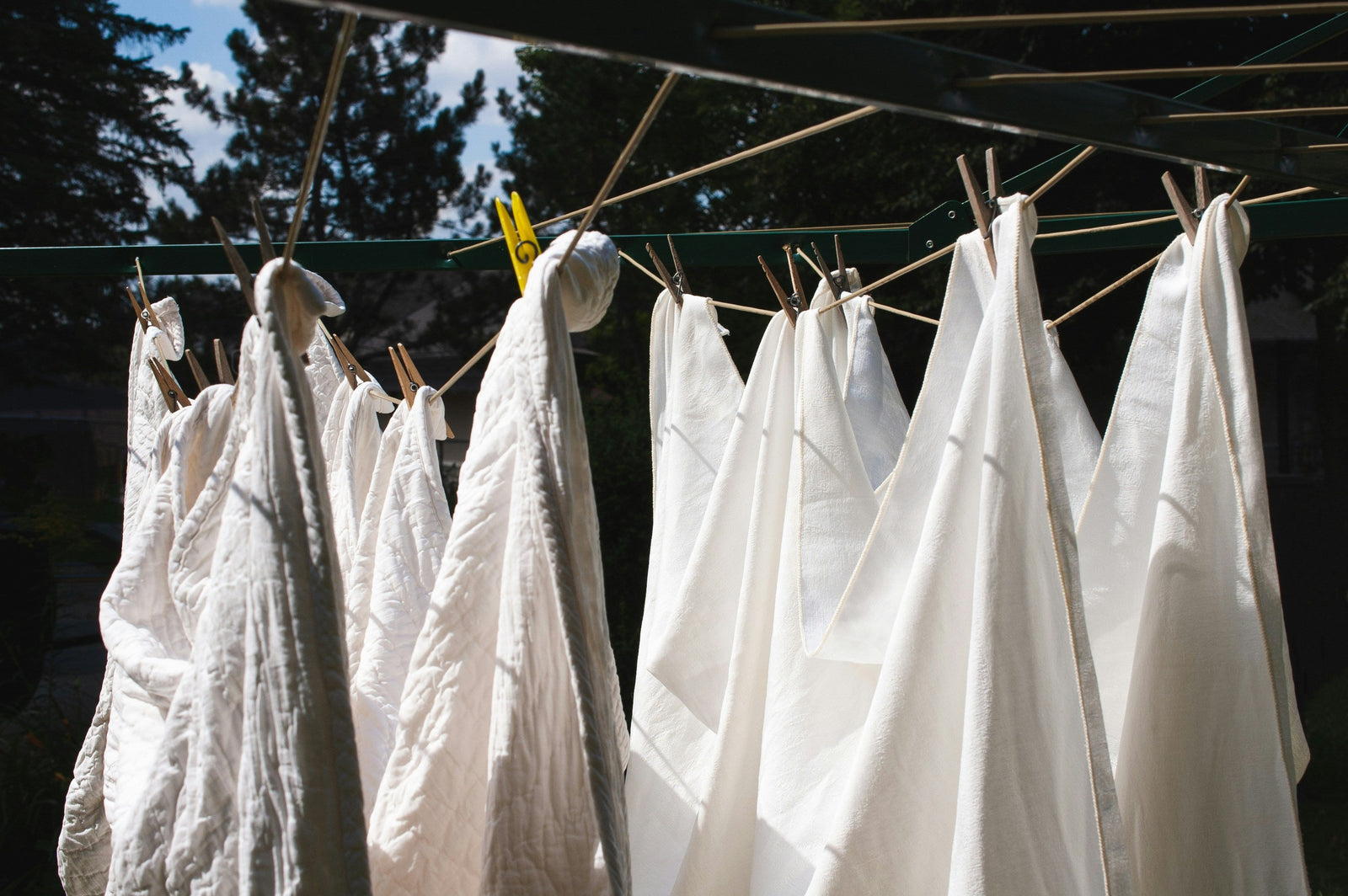How to Clean Your Window Blinds With Vinegar

Window blinds are an excellent choice for providing privacy to you and your home.
However, the slats, edges, and hard-to-reach spots can easily trap indoor pollutants like dust, dirt, grease, and grime, making regular cleanings essential.
Fortunately, you don’t need expensive, synthetic chemical-based cleaners or a ton of time to keep them clean.
In this article, we provide simple step-by-step instructions on how to clean window blinds with vinegar---a natural, safe, and effective versatile cleaning ingredient that cuts through dirt, dust, kitchen grease, grime, and more.
You'll also learn about other human-safe cleaning products you can use, like Branch Basics and microfiber cloths, as alternatives (especially if you aren’t a huge fan of vinegar).
Step 1: Mix Your Vinegar Solution
To get started, you’ll need to mix up your vinegar solution*.
To make:
Mix 1 part vinegar with 4 parts warm water in a large bowl.
Optional: For extra dirty blinds, add a few drops of natural dish soap, castile soap, or other natural soap like Branch Basics Concentrate.
Curious about which type of vinegar works best for cleaning blinds? Check out Cleaning Vinegar vs. White Vinegar: What’s the Difference? to help you decide.
Aside from vinegar, you can also use the following to clean your blinds:
- Microfiber cloth or a soft sponge
- HEPA vacuum cleaner with a brush attachment or an unscented microfiber duster
- Human-safe dish soap, castile soap, or natural soap like Branch Basics Concentrate
- Water
- Steam or dry steam cleaner
*Note: Although vinegar is a natural product, it contains acetic acid, a respiratory irritant when made airborne by spraying (which is why we recommend mixing and cleaning with it in a bowl versus a spray bottle).
Always ventilate when cleaning with vinegar! If you’re sensitive, have a respiratory condition, have babies, young children, or elderly in the house, etc., avoid spraying.
Step 2: Apply the Solution
With your vinegar solution ready, let’s look at how to apply it using gentle cleaning tools and the proper techniques based on the type of blinds you have.
Here’s how to apply and use vinegar to clean your window blinds:
Venetian (Horizontal) Blinds
These are the most popular types of home window blinds. They are made from various materials like plastic, vinyl, fabric, and real or faux wood.
How you apply the vinegar solution will depend on the blinds' materials.
For real or faux wood, read on for cleaning directions under “Real and Faux Wood Blinds”.
For vinyl, plastic, or fabric, use the following instructions.
Here’s how to clean Venetian window blinds with vinegar:
- First, dust or HEPA vacuum the blinds thoroughly to remove loose dirt and dust.
- Wet a clean microfiber cloth or sponge in the vinegar solution and wring out.
- Wipe each slat, working from top to bottom, front and back.
- Let air dry.
Pro cleaning tip: While cleaning, leave the blinds open, and slats tilted at a 180-degree angle. This will give you easy access to dust, vacuum, and wipe. It also provides proper airflow for a faster dry time.
Vertical Blinds
- To safely clean vertical blinds, remove the slats from the headrail.
- Lay each slat flat on the ground or a flat surface.
- Dust or gently HEPA vacuum the side facing up.
- Dip a microfiber cloth or sponge into the vinegar solution and wipe one side of the slats.
- Let dry, then flip over and repeat the process.
- Once dry, replace the slats.
Roller Blinds
- First, roll the blinds down and run a HEPA vacuum with the brush attachment over it.
- Then, dip a microfiber cloth into the vinegar solution and wipe down. Let dry before rolling back up.
Real and Faux Wood Blinds
Avoid getting real and faux wood blinds wet, as this can cause them to warp or damage them. Instead, HEPA vacuum them well and use a clean, dry microfiber cloth or unscented duster to remove bugs, dirt, and allergens.
Tips for Cleaning Edges & Hard-to-Reach Spots
Cleaning the slats is only half the job. It’s also important to tackle specific and often overlooked areas, like the edges and hard-to-reach spots.
For hard-to-reach spots, grab a step stool or ladder for easier access. Or, use an extendable unscented microfiber duster, or a HEPA vacuum attachment, to help reach the top sections.
If this is too much trouble, or you don’t have these tools, you can always remove the blinds and lay them on a flat, level surface for a more thorough clean.
To get into those stubborn edges and corners, dip an old soft-bristled toothbrush into the vinegar solution and gently scrub away the dirt and grime.
How Often Should You Clean Window Blinds?
To prevent dust, dirt, and bug buildup, you should aim to dust your window blinds at least once a week with a microfiber cloth, unscented duster, or HEPA vacuum.
We recommend monthly cleanings to remove any stuck-on grime, household allergens, or stains for a deeper clean.
And don’t forget to clean your windows, too! Check out our blog, How to Clean Your Windows With Vinegar: Our Method, where we also suggest cleaning your windows at least once a week.
Tips for Preventing Damage To Your Blinds
Window blinds are easy to damage, so it’s important to clean and handle them with care.
Here are a few tips to help prevent damage to your blinds while cleaning:
- Before cleaning with a new product or ingredient, always test a small, inconspicuous area to ensure it’s compatible with your blind’s material.
- Be gentle and take your time while cleaning. Hold the bottom of the blind to help keep it stable, and avoid pulling or tugging as you clean.
- If your blinds are made of real or faux wood, do not saturate or soak as this may cause the slats to warp or other damage.
- After cleaning, allow the blinds to dry before closing or rolling them back up. This will help prevent excess moisture from damaging the slats, and will also prevent mold growth.
As always, review and follow the manufacturer’s cleaning instructions before wetting the blinds or soaking them in water.
Not A Fan Of Vinegar for Cleaning? Here Are 4 Alternatives
Vinegar is known for its dirt-obliterating and natural cleaning qualities. But, it can irritate the lungs when sprayed, isn’t always an ideal cleaner, and, let’s face it…the smell isn’t for everyone.
That’s why we’ve compiled four of our favorite cost-effective, natural, and safe alternatives to vinegar for cleaning your window blinds. Read on for more.
Clean Your Blinds With Branch Basics
If you’re looking for an effective, human-safe, and natural way to clean your window blinds without vinegar, then Branch Basics is our first recommendation.
We formulated Branch Basics Concentrate as an all-in-one, human-safe product capable of replacing all types of cleaners, including vinegar.
Our Concentrate is safe, natural, and effective, making it ideal for cleaning most blind materials.
Here's how to clean window blinds with Branch Basics:
- Vacuum the blinds to remove bugs, dirt, and dust.
- Fill a large bowl with warm water. Add a few drops of Branch Basics Concentrate.
- Wet a clean microfiber cloth or sponge in the soapy water. Wring it out so the cloth is damp.
- Wipe each slat, working from top to bottom, front and back.
- Let dry, then vacuum again to remove any remaining dirt or dust.
For extra dirty or stained washable* blinds, we recommend soaking them in a tub of water and Branch Basics Concentrate*. Here’s how:
- Dust or vacuum the blinds to remove any loose dust and dirt.
- Fill a bathtub with warm water and 1 to 2 tablespoons of Branch Basics Concentrate. For extra stain-fighting power, add a scoop of Oxygen Boost. While wearing cleaning gloves, agitate the water with your hands to mix well.
- Remove the blinds from the window and gently place them in the soapy solution. Let soak for at least 10 minutes or up to a few hours depending upon how dirty the blinds are.
- Gently scrub each slat with a microfiber cloth or sponge, then rinse under warm running water.
- Using a clean, dry microfiber cloth, gently pat any excess water off, then hang to dry.
*Note: This method works best for vinyl, fabric, plastic, and polyester blinds. It is not recommended for real or faux wood.
Use a Microfiber Cloth And Warm Water
Probably the simplest and least toxic alternative to cleaning window blinds with vinegar is, well, water!
Pair it with the cleaning power of a microfiber cloth---one of our favorite and most recommended cleaning tools---to remove 99% of bacteria (plus dirt, dust, household allergens, and more!).
To use, dampen the microfiber cloth and gently wipe each slat. Let air dry.
Pro cleaning tip: To speed up the cleaning process, use tongs.
- Wrap a microfiber cloth around each end and secure it with rubber bands.
- Gently pinch the blind slat with the cloth-wrapped tongs and run them over each blade. Quick and easy!
Dry Steam Clean Your Blinds
Lastly, if cleaning window blinds with vinegar isn’t your thing, try dry steam cleaning.
The dry steam loosens and removes dirt, dust, and allergens often trapped between the slats.
These handy cleaning tools can also be used to deep clean window tracks and other nooks and crannies.
Here’s how to clean window blinds using a dry steam cleaner*:
- Extend and open the blinds.
- Dust or HEPA vacuum to remove any loose dirt and dust.
- *Dry steam clean blinds working from top to bottom, front and back.
- Wipe away any excess moisture with a clean microfiber cloth. Let dry.
*Note: Before cleaning, test a small, inconspicuous area to ensure the dry steam won’t damage the blind.
Advap Ladybug Dry Steam Cleaners are the gold standard for chemical-free disinfecting and cleaning and the only brand we recommend wholeheartedly.
The Ladybug is an easy-to-use, multi-purpose cleaner for various items in the home. It dries quickly, cleans, deodorizes, sanitizes, and kills dust mites, fleas, and other pests.
It also denatures allergens and lifts pet hair, making it easy to vacuum up later.
Related reading: Why We Recommend These Substitutes For Vinegar In Cleaning
Let Branch Basics Help You Create A Cleaner, Healthier Home
Now you know how to clean window blinds with vinegar and other natural, human-safe options.
To create and maintain a cleaner, healthier home, check out our Branch Basics Premium Starter Kits (available in refillable glass or plastic).
Each Starter Kit comes with refillable spray bottles, a bag of Oxygen Boost, and a bottle of our signature Concentrate to make All-Purpose, Bathroom, Streak Free, Laundry, and Foaming Wash.Interested in learning more tips and information on natural, human-safe cleaning in your home?
Check out our Toss the Toxins Online Course and read up on more cleaning techniques in our Wellness Center.
Categories

Marilee Nelson
Marilee Nelson is an Environmental Toxins expert who has spent nearly 30 years advocating for the chemically-sensitive and chronically-ill. She is a Board Certified Nutritionist, Certified Bau-Biologist and Bau-Biology Inspector and specializes in Food As Medicine. She has helped thousands of families and individuals identify, heal and recover from toxic exposures and is on a mission to revolutionize the way American families view their health.








